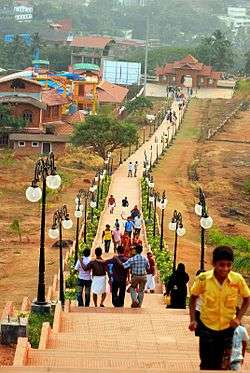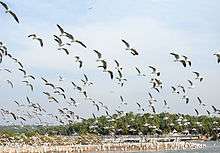Malappuram district
| Malappuram district മലപ്പുറം ജില്ല | |
|---|---|
| District | |
|
Kottakkunnu Hills in 2009, Malappuram | |
| Nickname(s): MLP | |
 Malappuram district | |
| Coordinates: 11°02′N 76°03′E / 11.03°N 76.05°ECoordinates: 11°02′N 76°03′E / 11.03°N 76.05°E | |
| Country | India |
| State | Kerala |
| Headquarters | Malappuram |
| Government | |
| • Collector | Amit Meena IAS |
| Area | |
| • Total | 3,550 km2 (1,370 sq mi) |
| Population (2011) | |
| • Total | 4,110,956 |
| • Rank | 1 |
| • Density | 1,158/km2 (3,000/sq mi) |
| Languages | |
| • Official | Malayalam, English |
| Time zone | IST (UTC+5:30) |
| ISO 3166 code | IN-KL-MLP |
| Vehicle registration | KL-10, KL-53, KL-54, KL-55, KL-65, KL-71 |
| Sex ratio | 1096 ♂/♀ |
| Literacy | 93.55% |
| Website |
www |
Malappuram district, with its headquarters at Malappuram, is a district in the state of Kerala, India. The district was formed on 16 June 1969. Malappuram district is composed of portions of the former Palakkad and Kozhikode districts: Ernad taluk and portions of Tirur taluk in Kozhikode district, and portions of Perinthalmannna and Ponnani taluks in Palakkad district.
Historically a stronghold of orthodox Brahminical Hinduism many famous scholars like Melpathur Narayana Bhattathiri who composed the Narayaneeyam in sanskrit, poonthanamnamboodiri and Thunchaththu Ramanujan Ezhuthachan came from Malappuram,the ancient Kerala school of astronomy and mathematics though mainly centred in Thrissur also had namboodiri and nair scholars coming from malappuram,Today The district includes Thirunavaya, the classic medieval center of Vedic learning; Kottakkal, home of Ayurveda medicine; islam came to malappuram early in prophet Mohammed's era itself. As a religion Islam spread in Malappuram district and slowly it became the major religion in the region, caste system present on those days was the major factor which made people to think about Islam, Ponnani, one of the oldest centres of Islamic education in the region is located here. In 1921 the present-day Malappuram district was part of the Moplah rebellions, followed by decades of stagnant economic, social and political development. In the early years of Communist rule in Kerala, Malappuram experienced land reform under the Land Reform Ordinance. During the 1970s Persian Gulf oil reserves were opened to commercial extraction, and thousands of unskilled workers migrated to the Gulf. They sent money home, supporting the rural economy, and by the late 20th century the region had First World health standards and near-universal literacy.[1]
Malappuram district contains abundant wildlife and a number of small hills, forests, rivers and streams flowing to the west, backwaters and paddy, arecanut, cashew nut, pepper, ginger, pulses, coconut, banana, tapioca, and rubber plantations. Malappuram is one of two Muslim-majority districts in south India. The Hindu temples and Moplah mosques of the region are known for their colorful festivals, and it is the most populous district in Kerala.[2] Religions practised in the district include Hinduism, Islam, Christianity, Buddhism, Sikhism, Jainism and tribal religions.[3]
History
Malappuram, meaning "terraced place atop the hills", derives from the geography of the district headquarters. Before the district's formation, the region was known as Eranad, Valluvanad, Vettathunad etc.
The district has a rich cultural and political heritage. The port of Ponnani (roughly identified with Tyndis) was a centre of trade with Ancient Rome. After the Chera Dynasty a number of dynasties controlled the area, and by the ninth century the region was ruled by the Kulasekharas of Mahodayapuram. After the disintegration of the Kulasekhara kingdom a number of Nair city-states emerged, including Valluvanad, Vettattunadu (Tanur), Parappanad and Nediyiruppu (ruled by the Zamorins). During the 13th century, the Samoothiri of Calicut expanded their territories to Malabar. Thirunavaya, the seat of Mamankam, was in Malappuram district.
European colonial powers first landed in Malabar during the 15th century, and the Samoothiris often allied with foreign powers. During the 18th century, the de facto Mysore kingdom rulers Hyder Ali and Tipu Sultan marched into the Samoothiris’ districts.
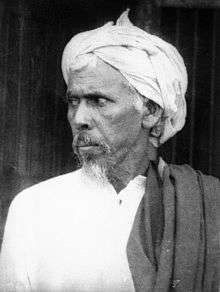
Malappuram has been part of movements such as Khilafat Movement and Moplah Rebellion in the early 20th century. Before Indian independence in 1947, Malappuram was part of Malabar District in the Madras Presidency of British India. The present district was administered as parts of Kozhikode, Eranad taluk, Valluvanad Taluk and Ponnani taluk. Malabar District remained part of Madras state for some time after independence, but on 1 November 1956 it merged with Travancore-Cochin to form the state of Kerala. Large-scale changes in the territorial jurisdiction of the region took place in 1957 and 1969. On 1 January 1957, Tirur taluk was formed from portions of Eranad taluk and Ponnani taluk. Another portion of Ponnani taluk was transferred to the new Chavakkad taluk, and the remainder is present-day Ponnani taluk. Perinthalmanna taluk was formed from the former Valluvanad Taluk. Of these, Eranad Taluk and Tirur remained in Kozhikode District and Perinthalmanna Taluk and Ponnani taluk remained in Palakkad District. The new district of Malappuram was formed with four taluks (Eranad, Perinthalmanna, Tirur and Ponnani), four towns, fourteen developmental blocks and 100 panchayats. Two more taluks, Tirurangadi taluk and Nilambur taluk, were formed from Tirur Taluk and Eranad taluk.
Geography
The district, in northern Kerala, is bounded on the northeast by Wayanad and northwest by Kozhikkode districts, on the northeast by Tamil Nadu, on the southeast and south by Palakkad District, on the southwest by Thrissur District and on the west by the Arabian Sea.
Rivers
- Bharathappuzha, also known as the River Nila
- Chaliyar: In the north of the district, the 169-kilometre (105 mi) Chaliyar rises in the Illambalieri hills of Tamil Nadu. Its tributaries are the Chalipuzha, Punnapuzha, Pandiyar, Karimpuzha, Cherupuzha and Vadapurampuzha. The Chaliyar crosses Nilambur, Mampad, Edavanna, Areekode, Vazhakkad, reaching the sea at Beypore in Kozhikode district. Of these rivers, the Chaliyar is the only perennial one; the others dry up in summer, and the district is drought-prone. The Chaliyar Action Committee, founded by K. A. Rahman in opposition to water and air pollution, began the Kerala environmental movement which continues in other parts of the state.
- Kadalundi River: The Kadalundi begains at the confluence of two rivers, the Olipuzha and the Veliyar; the Olipuzha begins on Cherakomban Hill, and the Veliyar on Erattakomban Hill. It flows through Silent Valley National Park, Eranad and Valluvanad before meeting the sea at Kadalundi. The 130-kilometre (81 mi) Kadalundi passes through Melattur, Pandikkad, Malappuram, Panakkad, Parappur, Kooriyad, Tirurangadi and Parappanangadi.
- Tirur River
In Tirur and Ponnani taluks, the villages of Biyyam, Veliyancode, Manur and Kodinhi have fishing and boating facilities.
Demographics
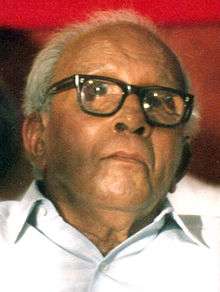
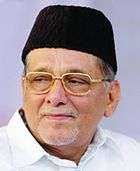
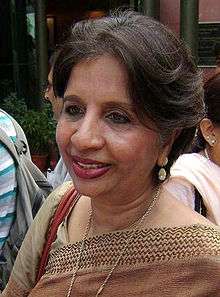
In the 2011 census the district had a population of 4,112,920,[2] roughly equal to that of New Zealand[4] and the US state of Oregon.[5] Malappuram is the 50th-most-populous of India's 640 districts,[2] with a population density of 1,158 inhabitants per square kilometre (3,000/sq mi).[2] Its population-growth rate from 2001 to 2011 was 13.39 percent.[2] Malappuram has a sex ratio of 1096 women to 1000 men,[2] and its literacy rate is 93.55 percent.[2]
Languages
Malayalam is the district's principal language. Minority Dravidian languages are Allar (350 speakers)[6] and Aranadan, kept alive by the low education level of its 200 speakers.[7]
Administration
Indian Parliament Constituencies
- Malappuram
- Ponnani
Taluks
- Ernad
- Tirur
- Tirurangadi
- Ponnani
- Perintalmanna
- Nilmabur
- Kondotty
Kerala Assembly Constituencies
Malappuram, Manjeri, Kondotty, Eranad, Mankada, Perinthalmanna, Thirurangadi, Vengara, Vallikkunnu, Tirur, Tanur, Kottakkal, Nilambur, Wandoor, Ponnani and Tavanur
Tourism
Art and culture
Thunchath Ezhuthachan, the father of Malayalam literature, was born in Trikkandiyur _Tirur]]). Mampuram was a centre of the Moplah Rebellion of 1921, and Mampuram Thangal is buried there. It is the birthplace of Omar Qazi, a Muslim scholar and a leader of anti-British movements. Kathakali musician Tirur Nambissan was born in Ezhoor, and the poets Mahakavi Vallathol Narayana Menon, V.C. Balakrishna Paniker and Moyinkutty Vaidyar were born in Malappuram. Malappuram is also the birthplace of Poonthanam, remembered for his poetic masterpiece "Jnanappana".
Kerala school of astronomy and mathematics
Mathematicians from Madhava of Sangamagrama's Kerala school of astronomy and mathematics Melpathur Narayana Bhattathiri, Achyuta Pisharati and Kelallur Nilakantha Somayaji were born in Thrikandiyur in Tirur. Melpathur Narayana Bhattathiri is known for his Narayaneeyam.
Fairs and festivals
Kondotty Nercha is a week-long festival in March at the 18th-century Pazhayangadi Mosque. The tomb of the Sufi Mohammed Shah is near the Mughal-style mosque. The Andu Nercha of Puthenpalliis held at Perumpadappu, in the southwestern part of the district. During the festival, ney choru (rice with ghee) is distributed to devotees and the poor. The Omanoor Nercha is a mosque festival which commemorates martyrs.
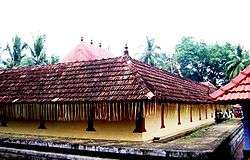
Vairamkode Vela (temple festival), or Theeyaattu, is a six-day festival held in February from Sunday to Friday featuring processions, fireworks and markets. The seven-day Thirumandhamkunnu pooram, in March or April, is a temple festival in central Malabar. Tirumanthamkunnu Temple is, with Kodungallur and Panayarakavu, one of Kerala's three main Bhagavati temples. Kottakkal is also noted for its March–April temple festival, Kottakkal pooram, where Indian classical artists perform. The Nilambur Pattu is a week-long festival, held in January at its Kovilakam. The Malaparamba Perunnal is a church festival in Malaparamba, near Angadipuram, and there are also summer church festivals in Pariyapuram, Chungathara and Edakkara.
Industry
About 1,000 people are aided annually under a self-employment programme. There are KINFRA food-processing and IT industrial estates in Kakkancherry, Inkel SME Park at Panakkad for Small and Medium Industries and a rubber plant and industrial estate in Payyanad. MALCOSPIN, The Malappuram Spinning Mills Limited is one of the oldest industrial establishment in the district under state Government. Wood-related industries are common in Kottakkal, Edavanna, Vaniyambalam, Karulai, Nilambur and Mampad. Sawmills, furniture manufacturers and the timber trade are the most important businesses in the district. Employees' State Insurance has its branch office at Malappuram. Wood-related industries are in Kottakkal, Edavanna, Vaniyambalam, Karulai, Nilambur and Mampad. Sawmills, furniture manufacturers and the timber trade are the most important businesses in the district. Employees' State Insurance has a branch office in Malappuram.
As of July 2013, Malappuram is the highest beneficiary in receiving donations from migrants abroad among all the districts in Kerala.[8]
Healthcare
Malappuram currently has two Medical colleges, Government Medical College, Malappuram and MES Medical College. All the towns of the district has multiple quality hospitals both in government and private sector. Out of which the towns of Perinthalmanna and Kottakkal attracts a large number of patients under general as well as health tourism category. Considering the number of health related institutions established and upcoming in the district, Government of Kerala has decided to promote the region as Health city under Vision 2030.
Presently, Malappuram is one of the leading district in India which have most number of medical students as undergraduates studying at various colleges across the country and abroad.
Transport

Air
Calicut International Airport is in Karipur, 25 kilometres (16 mi) from the Malappuram city centre.
Rail
Two railway lines pass through the district. The Mangalore-Madras line runs along the coast, with stations (from north to south) at Vallikkunnu, Parappanangadi, Tanur, Tirur, Tirunavaya and Kuttippuram. The Nilambur–Shoranur railway line runs through the eastern part of the district, with stations at Nilambur, Vaniyambalam, Thuvur, Melattur, Pattikkad, Angadipuram and Cherukara.
Road
Bus service is available throughout the district, with 93 routes operated by Kerala State Road Transport Corporation (KSRTC) on major roads and 300 intercity routes passing through the district. There are four KSRTC bus stations, at Malappuram Depot, Ponnani, Perinthalmanna and Nilambur.
National Highway 17, renumbered NH 66, enters the district at Idimuzhikkal in the north and runs for 82 kilometres (51 mi) through Calicut University, Kottakkal, Valanchery, Kuttipuram, Thavanur, Ponnani, Puduponnani, Veliyancode and Kadikkad before entering Thrissur district in the south. National Highway 213, renumbered NH 966, enters the district at Iykarappadi (near Ramanattukara) and runs for 68 kilometres (42 mi) through Kondotty, Malappuram and Perinthalmanna to Karinkallathani.
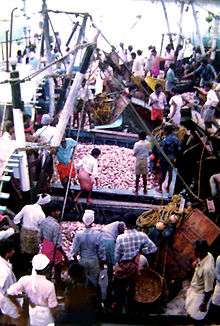
State highways such as Tirur-Malappuram-Manjeri, Malappuram-Parappanangadi, Valanchery-Nilambur and the Kozhikode-Nilambur-Gudalur road pass through the district. The district has 208 kilometres (129 mi) of state highway, 1,220 kilometres (760 mi) of major district roads, 102 kilometres (63 mi) of other district roads and 160 kilometres (99 mi) of rural roads.
The Chaliyar, Kadalundipuzha, Bharathapuzha and Thutha rivers and their tributaries flow through the district, requiring a number of road bridges. Bridges include the Kuttippuram, Thutha and Pulamanthole bridges across the Bharathapuzha, bridges at Kottakadavu, Parakkadav, Thayyilakadav, Panampuzha, Koomankallu, Nooradi, Kottilangadi, Aanakkayam, Melattur, Kalikavu, Olipram Kadavu, Koomankallu, Kuzhipram Kadavu and Panakkadu across the Kadalundi River, bridges at Areekode, Edavanna, Mampad, Vadapuram, Myladi, Karimpuzha, Koorad, Kattadikadavu, Cherupuzha, Kadungallur and Poonkudi across the Chaliyar and its tributaries and bridges at Edakulam, Thalakadathur, Tirur, Unniyal, Mangattiri, Ettirikkadavu across the Tirur River.
Proposed projects
- Formation of a Malappuram Development Authority for the sustainable development of Malappuram and its surrounding panchayats, similar to the development authorities of other cities in the state
- Rerouting of NH66 from Chamaravattom to Chelari via Tirur, Parappanangadi
- A Kozhikode-Malappuram-Angadipuram-Ottappalam railway line connecting Malappuram with Karippur Airport and Kozhikode.
- Expediting construction of the KSRTC bus terminal and shopping complex in Uphill
- Expediting Edu-Health City construction in Panakkad, including a cancer hospital
- Modernisation and relocation of Down Hill Market and bus stand to Down Hill bypass area
- Completion of the Kottappadi Bypass
- A new road from Malappuram to Valanchery, as proposed in Malappuram District Urbanization Report by state planning department.
- Two new National Highways: Malappuram-Manjeri-Gudalur and Malappuram-Kolathur-Pulamanthol-Thrissur
Education
The district has four education districts (Tirur, Malappuram, Wandoor and Tirurangadi) and 17 education sub-districts. The University of Calicut is in Thenjipalam, and AMU (Aligarh Muslim University) Malappuram Centre is in Chelamala. Thunchaththu Ezhuthachan Malayalam University is in Thunchan Parambu, 26 kilometres (16 mi) from the Malappuram city centre.
Medical colleges
- Government Medical College, Malappuram at Manjeri
- M.E.S. Medical College at Perinthalmanna
- Educare Institute of Dental Sciences, Chattiparamba, Malappuram[9]
Nursing Colleges
- Almas College Nursing
- Al Shifa College of Nursing
- EMS Memorial Cooperative Hospital College of Nursing
- Moulana Hospital College of Nursing
- MES Medical College College of Nursing[10]
Engineering colleges
- Calicut University Institute of Engineering and Technology, Thenhipalam
- Eranad Knowledge City Technical Campus (EKC), Cherukulam, Manjeri
- Kelappaji College of Agricultural Engineering and Technology, Tavanur
- M.E.S. Engineering College, Kuttippuram
- M.E.A. Engineering College, Perinthalmanna
- Veda Vyasa Institute of Technology, Karadparamba
- Cochin College of Engineering and Technology, Valancheri
Arts & Science Colleges
- Government College, Malappuram
- Government women's College, Malappuram
- GEMS Arts and Science college, Ramapuram, Malappuram
- Ma'din Arts and Science college, Malappuram
- Priyadarshini College, Malappuram
- NSS College Manjeri
- Government College, Mankada
- Government College, Kondotty
- EMEA Arts and Science College, Kondotty
- SAFI College, Vazhayur, Kondotty
- SAFA College of arts and science,valanchery
- Amal College of Advanced Studies, Nilambur
- Majlis Arts & Science College, Valanchery
- Al Salama Group Of Institutions, Hospital Road, Perinthalmanna
- PTM Gov't Collage, Perintalmanna
- Mar Thoma College Chungathara
- MES Ponnani College, Ponnani
- MES Mambad College
- PSMO College, Tirurangadi
Law Colleges
- MCT College of Legal studies, Malappuram
- KMCT Law College, Kuttippuram
Schools
There are 1,472 schools in Malappuram District including 254 highschools.
Post and telecommunications
The district has two postal divisions (Manjeri and Tirur), four head post offices, 120 post sub-offices and 284 branch post offices. Speed post facilities are in Malappuram, Manjeri, Perinthalmanna, Calicut University, Karipur, Ponnani, Kottakkal, Kuttippuram and Edappal.
For telecommunications, the district is in the Malappuram Secondary Switching Area. Divisional offices are in Manjeri, Nilambur, Perinthalmanna, Tirur, Ponnani and Parappanangadi.
Media
The morning daily newspapers Suprabhaatham, Malayala Manorama, Mathrubhumi, Madhyamam, Chandrika and Deshabhimani have printing centres in the district. Prahelika and the Flash are the evening dailies. Monthly, fortnightly and weekly periodicals, primarily devoted to religion and culture, are also published. Local cable-TV channels include Malappuram Cable Vision (MCV), Asianet Cablevision (ACV) and Den Malabar Vision. The Malappuram Press Club is in Up Hill. Doordarshan has relay stations at Malappuram and Manjeri, and All India Radio has an FM station at Manjeri.
See also
References
- ↑ "Summer Journey 2011". Time. 21 July 2011.
- 1 2 3 4 5 6 7 "District Census 2011". Census2011.co.in. 2011. Retrieved 2011-09-30.
- ↑ pp. 396, Malayala Manorama Yearbook 2006, Kottayam, 2006 ISSN 0970-9096
- ↑ New Zealand
- ↑ "2010 Resident Population Data". U. S. Census Bureau. Retrieved 2011-09-30.
Oregon 3,831,074
- ↑ M. Paul Lewis, ed. (2009). "Allar: A language of India". Ethnologue: Languages of the World (16th ed.). Dallas, Texas: SIL International. Retrieved 2011-09-28.
- ↑ M. Paul Lewis, ed. (2009). "Aranadan: A language of India". Ethnologue: Languages of the World (16th ed.). Dallas, Texas: SIL International. Retrieved 2011-09-28.
- ↑ "Gulf money fueling Muslim extremism in Kerala; IUML grows more militant to take on other radical islamist parties". The Economic Times. 3 July 2013.
- ↑ "Educare Institute of Dental Sciences". Retrieved 20 July 2015.
- ↑ nursingcouncil.kerala.gov.in
External links
| Wikimedia Commons has media related to Malappuram district. |
| Wikivoyage has a travel guide for Malappuram District. |
- Official website of Malappuram district
- Places in Malappuram
 |
Kozhikode district | Wayanad district | Nilgiris district, Tamil Nadu |  |
| Arabian Sea(Lakshadweep Sea) | |
|||
| ||||
| | ||||
| Thrissur district | Palakkad district |
